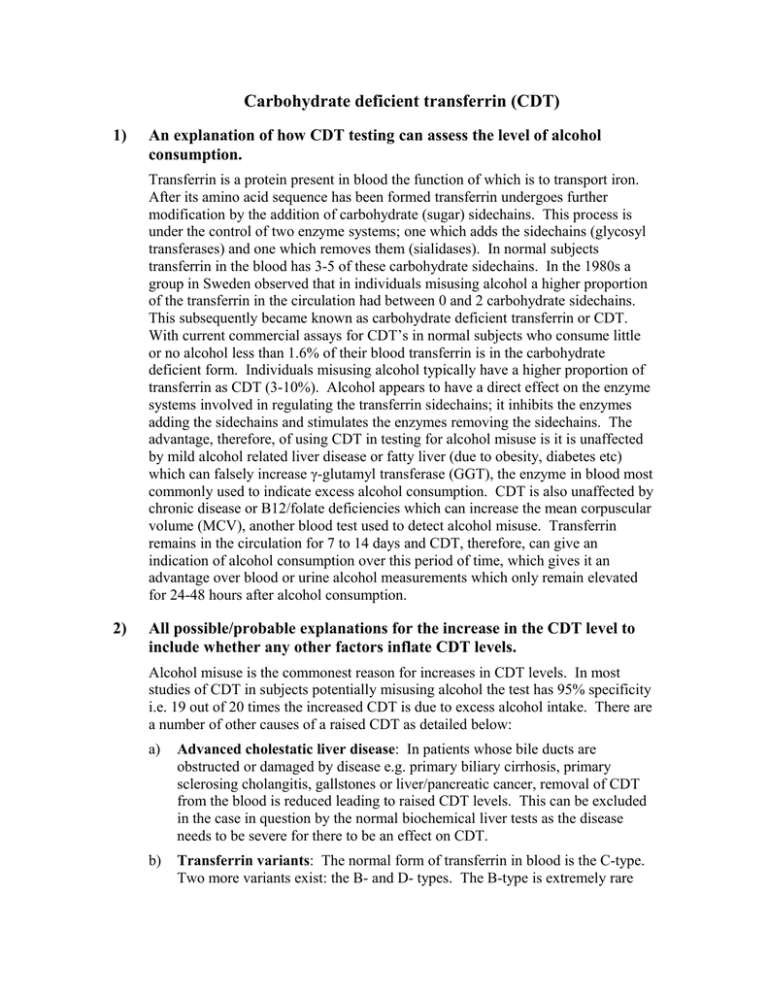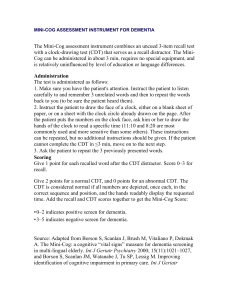Carbohydrate deficient transferrin (CDT)
advertisement

Carbohydrate deficient transferrin (CDT) 1) An explanation of how CDT testing can assess the level of alcohol consumption. Transferrin is a protein present in blood the function of which is to transport iron. After its amino acid sequence has been formed transferrin undergoes further modification by the addition of carbohydrate (sugar) sidechains. This process is under the control of two enzyme systems; one which adds the sidechains (glycosyl transferases) and one which removes them (sialidases). In normal subjects transferrin in the blood has 3-5 of these carbohydrate sidechains. In the 1980s a group in Sweden observed that in individuals misusing alcohol a higher proportion of the transferrin in the circulation had between 0 and 2 carbohydrate sidechains. This subsequently became known as carbohydrate deficient transferrin or CDT. With current commercial assays for CDT’s in normal subjects who consume little or no alcohol less than 1.6% of their blood transferrin is in the carbohydrate deficient form. Individuals misusing alcohol typically have a higher proportion of transferrin as CDT (3-10%). Alcohol appears to have a direct effect on the enzyme systems involved in regulating the transferrin sidechains; it inhibits the enzymes adding the sidechains and stimulates the enzymes removing the sidechains. The advantage, therefore, of using CDT in testing for alcohol misuse is it is unaffected by mild alcohol related liver disease or fatty liver (due to obesity, diabetes etc) which can falsely increase γ-glutamyl transferase (GGT), the enzyme in blood most commonly used to indicate excess alcohol consumption. CDT is also unaffected by chronic disease or B12/folate deficiencies which can increase the mean corpuscular volume (MCV), another blood test used to detect alcohol misuse. Transferrin remains in the circulation for 7 to 14 days and CDT, therefore, can give an indication of alcohol consumption over this period of time, which gives it an advantage over blood or urine alcohol measurements which only remain elevated for 24-48 hours after alcohol consumption. 2) All possible/probable explanations for the increase in the CDT level to include whether any other factors inflate CDT levels. Alcohol misuse is the commonest reason for increases in CDT levels. In most studies of CDT in subjects potentially misusing alcohol the test has 95% specificity i.e. 19 out of 20 times the increased CDT is due to excess alcohol intake. There are a number of other causes of a raised CDT as detailed below: a) Advanced cholestatic liver disease: In patients whose bile ducts are obstructed or damaged by disease e.g. primary biliary cirrhosis, primary sclerosing cholangitis, gallstones or liver/pancreatic cancer, removal of CDT from the blood is reduced leading to raised CDT levels. This can be excluded in the case in question by the normal biochemical liver tests as the disease needs to be severe for there to be an effect on CDT. b) Transferrin variants: The normal form of transferrin in blood is the C-type. Two more variants exist: the B- and D- types. The B-type is extremely rare and is of no relevance in this case as it causes falsely low CDT results. The D type is very rare in Caucasians, with a prevalence of less than one in 10,000, but has been shown to cause falsely raised CDT levels. It is more common in Africans, in whom studies have shown a prevalence of CD heterozygotes of up to 10%. c) 3) Carbohydrate deficient glycoprotein syndromes: A group of very rare syndromes has now been identified in which an inherited deficiency of the enzymes that add the sidechains to proteins occurs. To date only around 200 cases have been described in the literature. In an affected child there is severe mental retardation together with other physical abnormalities and CDT levels are in the range 50-100%. In heterozygous, or carriers of the disease, CDT levels are variable but typically are in the range 10-25%. Level of alcohol consumption necessary and over what period to increase the CDT level to 3.0%. Typically the level of alcohol intake required to produce a CDT result of 3.0% is 100-150 g alcohol/day. This equates to about 5 pints of beer, a bottle of wine or one third of a bottle of spirits daily. As stated earlier the half-life of transferrin in blood is 7 - 14 days so excess intake would need to fall within this time period. It is important at this stage to add the caveat that the relationship between amount of alcohol consumed and percent CDT is not as reliable in pre-menopausal women compared to men or post-menopausal women. It is believed that this is due to the changes in hormones in the blood during the menstrual cycle or present in oral contraceptives affecting the enzymes involved in regulating the carbohydrate sidechains. There is very little information regarding CDT and HRT (hormone replacement therapy). Total transferrin concentrations increase throughout pregnancy reflecting the increased requirement for iron of the developing foetus. Although earlier studies expressing CDT in absolute values demonstrated an increase in CDT in the third trimester there is no evidence that pregnancy itself causes an increase in CDT values when expressed as a percentage of total transferrin. 4) Can CDT levels be increased by intermittent drinking? Intermittent or “binge” drinking can increase CDT levels. The extent to which this occurs is dependent on the frequency of “binges” and the amount of alcohol consumed on each occasion. Someone drinking 200-300 g alcohol two days a week, but abstaining on the other days, could have a CDT level of 1.5-3%. Conversely, someone who only has one “binge” in a 14 day period and does not consume alcohol for the rest of the time period is unlikely to have a raised CDT, as the normal transferrin produced on the other 13 days would ‘dilute’ the CDT produced on the day of drinking. 5) Analytical and biological variation The analytical variability of the CDT assay in use at King’s College Hospital is approximately 4-5% C.V. at a CDT concentration of 1.3%. Variation is lower at higher CDT concentrations. Occasionally a subject’s total transferrin concentration is so low that acceptable reproducibility cannot be obtained. Biological variability in CDT in any one individual is low - < 10% in our experience, with the possible exception of pre-menopausal women as detailed in point 3 above. It is, therefore, advisable to base any conclusions on the drinking status of an individual on at least two emasurements of CDT, two weeks or more apart. Our recommendation is for three samples at two-weekly intervals, particularly in pre-menopausal women as this spans at least two different stages of the menstrual cycle. 6) Conclusions CDT testing for alcohol misuse should not be undertaken in isolation, but should be combined with medical history and examination, appropriate questionnaires and other laboratory parameters e.g. MCV, GGT etc. Dr Roy Sherwood Consultant Clinical Scientist and Hon Senior Lecturer in Clinical Biochemistry King’s College Hospital Denmark Hill London SE5 9RS May 2008





